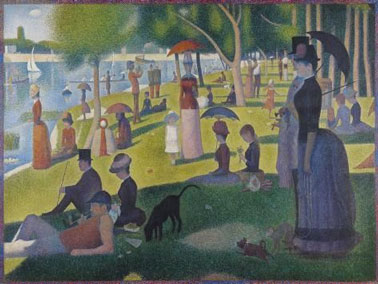
The Sunday afternoon of Dawandao is from 1884 to 1886, and is the most famous work of George Seurat. This is a leading example of stippling techniques performed on large canvases. Serrat's work includes many Parisians in the park on the banks of the Seine. Serrat's painting is a mirror image of his own painting "The Bather of Asnier", which was completed shortly after 1884. Although the bather in that early painting is dim, almost every figure on La Grande Jart seems to be cast under a tree, under an umbrella, or in the shadow of other people. For Parisians, Sunday is a day to escape the heat of the city and head to the shade of the trees and the breeze of the river. At first glance, the audience saw many different people relaxing in the park by the river. On the right is a stylish couple, a woman with sunshade and a man in a top hat. On the left, another well-dressed woman sticks a fishing rod out of the water. There was a little man wearing a black hat and a thin walking stick looking at the river, and a brown white dog, a woman knitting, a man blowing the horns, two musicians were standing while playing, and a woman bending over Under the orange umbrella. Seurat also used a pipe to paint the men, and some characters were doing strange things. The lady on the right has a monkey on the belt. The lady on the left near the river bank is fishing. The area was known as a place where prostitutes were bought among the bourgeoisie, which may be an allusion to the originally peculiar "fishing" rod. In the center of the painting stood a little girl in white clothes, staring directly at the audience of the painting. This can be explained as a person who silently asks the audience: "What will these people and their class become?" Sera described their bleak future, covering up their shadows and doubts about crime. In the 1950s, historian and Marxist philosopher Ernst Bloch drew social and political meaning from Seurat's "The Grand Grant." The focus of historians is on Serrat's mechanical use of characters and the influence of the static nature of the characters on French society at that time. Later, the work was strongly criticized by many critics, who focused on the artist's mathematical and robotic interpretation of Parisian modernity. According to the modernist historian William R. Everdel: Serrat himself told the sympathetic critic Gustav Kahn that his model was the Pan-Hellenic procession of the Parthenon. But Serat did not want to paint ancient Athenians. He wanted to "make modern people pass in a basic form...". What he means by "modern man" is not very complicated. He hopes that ordinary people will become his subject and pursue ordinary lives. He is a bit democratic, as one of his friends said, "communism", referring to the left-wing revolutionaries in 1871. He is fascinated by the completely different ways of encountering things: cities and villages, farms and factories, the meeting of the bourgeoisie and the proletariat meet on the edge of opposition. The borders of this painting are usually inverted colors, as if the world around them is slowly turning over from the lifestyle they know.
Comments
Add Comment